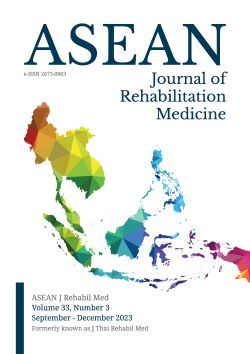The Efficacy of Ortho-Prosthesis and Knee Ankle Foot Orthosis on Functional Gait Activities in Pediatric Congenital Limb Deficiency: A Case Report
Keywords:
tibia hemimelia, knee ankle foot orthosis, ortho-prosthesis, congenital femoral deficiencyAbstract
Objectives: This study aimed to demonstrate the efficacy of ortho-prosthesis and knee-ankle foot orthosis (KAFO) in improving functional gait activities in children with congenital limb deficiencies.
Study design: A case report.
Setting: Sirindhorn School of Prosthetics and Orthotics, Faculty of Medicine Siriraj Hospital, Mahidol University.
Subjects: The study presents the case of a 10-year-old child with a left congenital femoral deficiency with fibular hemimelia and right tibial hemimelia.
Methods: A pediatric orthopedist provided surgical treatment, and a prosthetist and orthotist prescribed the design, choosing the appropriate KAFO for the right side and ortho-prosthesis for the left side. Outcome measurements were recorded using the Four Square Step Test (FSST), Time Up and Go (TUG) Test, and the 10-Meter Walk Test after using the devices for two and five months.
Results: The results of FSST and TUG showed improvement after five months of training, with 19.69% and 34.25% less time required, respectively. The parameters of the 10-Meter Walk Test also improved after five months of training.
Conclusions: Appropriate fitting of different devices and training using those devices can help improve balance and functional gait activities in children with congenital limb deficiencies.
References
Morris CD, Potter BK, Athanasian EA, Lewis VO. Extremity amputations: principles, techniques, and recent advances. Instr Course Lect [Internet]. 2015 [cited 2022 July 22];64:105-17. Available from: https://pubmed.ncbi.nlm.nih.gov/25745899
Boonstra AM, Rijnders LJ, Groothoff JW, Eisma WH. Children with congenital deficiencies or acquired amputations of the lower limbs: functional aspects. Prosthet Orthot Int [Internet]. 2000 [cited 2022 July 30];24(1):19-27. Available from: https://pubmed.ncbi.nlm.nih.gov/10855435/ doi: 10.1080/03093640008726518
Nossov SB, Hollin IL, Phillips J, Franklin CC. Proximal Femoral Focal Deficiency/Congenital Femoral Deficiency: Evaluation and Management. J Am Acad Orthop Surg [Internet]. 2022 [cited 2022 July 31];30(13):e899-e910. Available from: https://pubmed.ncbi.nlm.nih.gov/35486897/ doi: 10.5435/JAAOS-D-21-01186
Eshraghi A, Safaeepour Z, Geil MD, Andrysek J. Walking and balance in children and adolescents with lower-limb amputation: A review of literature. Clin Biomech (Bristol, Avon) [Internet]. 2018 [cited 2022 August 8];59:181-98. Available from: https://pubmed.ncbi.nlm.nih.gov/30268996/ doi: 10.1016/j.clinbiomech.2018.09.017.
Paley D. Tibial hemimelia: new classification and reconstructive options. J Child Orthop [Internet]. 2016 [cited 2022 August 28];10(6):529-55. Available from: https://www.ncbi.nlm.nih.gov/pmc/articles/PMC5145835/ doi: 10.1007/s11832-016-0785-x
Kulkarni RM, Arora N, Saxena S, Kulkarni SM, Saini Y, Negandhi R. Use of Paley Classification and SUPERankle Procedure in the Management of Fibular Hemimelia. J Pediatr Orthop [Internet]. 2019 [cited 2022 August 28];39(9):e708-e17. Available from: https://pubmed.ncbi.nlm.nih.gov/31503232/ doi: 10.1097/BPO.0000000000001012
Edelstein JE, Denninger SA. 29 - Rehabilitation for Children With Limb Deficiencies. In: Chui KK, Jorge MM, Yen S-C, Lusardi MM, editors. Orthotics and prosthetics in rehabilitation [Internet]. 4th ed. St. Louis (MO): Elsevier; 2020 [cited 2022 September 29]. p. 738-58. Avalaible from: https://www.us.elsevierhealth.com/orthotics-and-prosthetics-in-rehabilitation-9780323609135
Wong CK, Chihuri ST, Li G. Risk of fall-related injury in people with lower limb amputations: A prospective cohort study. J Rehabil Med [Internet]. 2016 [cited 2022 October 15];48(1):80-5. Available from: https://pubmed.ncbi.nlm.nih.gov/26694526/ doi: 10.2340/16501977-2042
Verma A, Samuel AJ, Aranha VP. The four square step test in children with Down syndrome: Reliability and concurrent validity. J Pediatr Neurosci [Internet]. 2014 [cited 2022 October 24];9(3):221-6. Avalible from: https://pubmed.ncbi.nlm.nih.gov/25624923/ doi: 10.4103/1817-1745.147573
Ziegl A, Hayn D, Kastner P, Löffler K, Weidinger L, Brix B, et al. Quantitative falls risk assessment in elderly people: results from a clinical study with distance based timed up-and-go test recordings. Physiol Meas [Internet]. 2020 [cited 2022 October 24];41(11):115006. Available from: https://pubmed.ncbi.nlm.nih.gov/33086193/ doi: 10.1088/1361-6579/abc352
Graff K, Szczerbik E, Kalinowska M, Kaczmarczyk K, Stępień A, Syczewska M. Using the TUG Test for the Functional Assessment of Patients with Selected Disorders. Int J Environ Res Public Health [Internet]. 2022 [cited 2022 November 11];19(8). Available from: https://pubmed.ncbi.nlm.nih.gov/35457472/ doi: 10.3390/ijerph19084602.
Voss S, Joyce J, Biskis A, Parulekar M, Armijo N, Zampieri C, et al. Normative database of spatiotemporal gait parameters using inertial sensors in typically developing children and young adults. Gait Posture [Internet]. 2020 [cited 2022 November 11];80:206-13. Available from: https://www.ncbi.nlm.nih.gov/pmc/articles/PMC7388584/ doi: 10.1016/j.gaitpost.2020.05.010
Downloads
Published
How to Cite
Issue
Section
License

This work is licensed under a Creative Commons Attribution-NonCommercial-NoDerivatives 4.0 International License.






